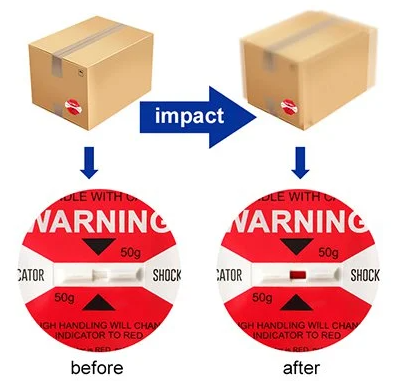Please do not hesitate to contact us if you have any question and enquiry.
Contact UsShipping damage indicators have undergone a remarkable transformation over the years, evolving from rudimentary tools to sophisticated, technology-driven devices that provide unparalleled protection for goods in transit. This evolution reflects the ever-increasing demand for enhanced cargo security and the relentless pursuit of innovative solutions to mitigate the risks associated with shipping. In this article, we delve into the historical development of shipping damage indicators, examining their progression from conventional to cutting-edge technologies such as shipping impact indicators, shipping impact sensors, shipping shock indicators, and shock indicators for shipping.

The concept of monitoring cargo integrity during transportation has its roots in simple, yet effective, early warning systems. Initial iterations of shipping damage indicators were primarily mechanical devices, designed to visually signal when a shipment had experienced excessive force or rough handling. These included:
1. Tilt Indicators: Simple, gravity-based mechanisms that change color or display an irreversible message when a package is tilted beyond a predetermined angle, indicating possible mishandling.
2. Impact Labels: Adhesive-backed labels with breakable elements, such as glass vials containing liquid dyes or fragile internal structures, which rupture upon impact, revealing visible evidence of rough handling.
While these traditional indicators provided a basic level of protection, they had limitations in terms of sensitivity, accuracy, and the ability to capture nuanced data about the nature and extent of impacts sustained by the cargo.
The advent of electronic technology marked a significant turning point in the evolution of shipping damage indicators. These advancements enabled the development of more precise, responsive, and data-rich devices, such as:
1. Electronic Shock & Vibration Recorders: Miniaturized, battery-powered devices that log and store impact and vibration data throughout the shipping process. Upon arrival, the data can be downloaded and analyzed to identify specific events, severity levels, and timestamps, providing valuable insights for damage investigations and supply chain optimization.
2. Wireless Impact Sensors: IoT-enabled sensors that transmit real-time impact and environmental data (e.g., temperature, humidity) via Bluetooth or cellular networks to a centralized monitoring system. This enables immediate alerts for critical incidents and offers continuous visibility into cargo conditions, allowing for proactive intervention if necessary.
The latest generation of shipping damage indicators leverages advanced technologies like artificial intelligence, cloud computing, and big data analytics to deliver unprecedented levels of protection and insight. Key examples include:
1. AI-Powered Impact Analytics: Integrated with wireless impact sensors, AI algorithms analyze incoming data streams to detect patterns, predict potential damage, and generate customized recommendations for improving packaging, routing, or handling procedures.
2. Blockchain-Enabled Transparency: By integrating shipping damage indicators with blockchain platforms, stakeholders can access tamper-proof, immutable records of cargo condition data, enhancing trust, accountability, and dispute resolution in the supply chain.
As the shipping industry continues to embrace digitalization and automation, shipping damage indicators will undoubtedly evolve further. Emerging technologies such as printable electronics, flexible sensors, and nanotechnology hold promise for creating even more lightweight, cost-effective, and environmentally sustainable monitoring solutions. Moreover, advancements in machine learning and predictive analytics will enable more accurate risk assessments and proactive damage prevention strategies.

In conclusion, the evolution of shipping damage indicators mirrors the relentless drive for innovation in the realm of cargo security. From their humble beginnings as mechanical warning signs to today's cutting-edge, smart, and connected devices, shipping impact indicators, shipping impact sensors, shipping shock indicators, and shock indicators for shipping have transformed the way businesses protect their goods in transit, ensuring the integrity and value of global trade.
By continuing to use the site you agree to our privacy policy Terms and Conditions.